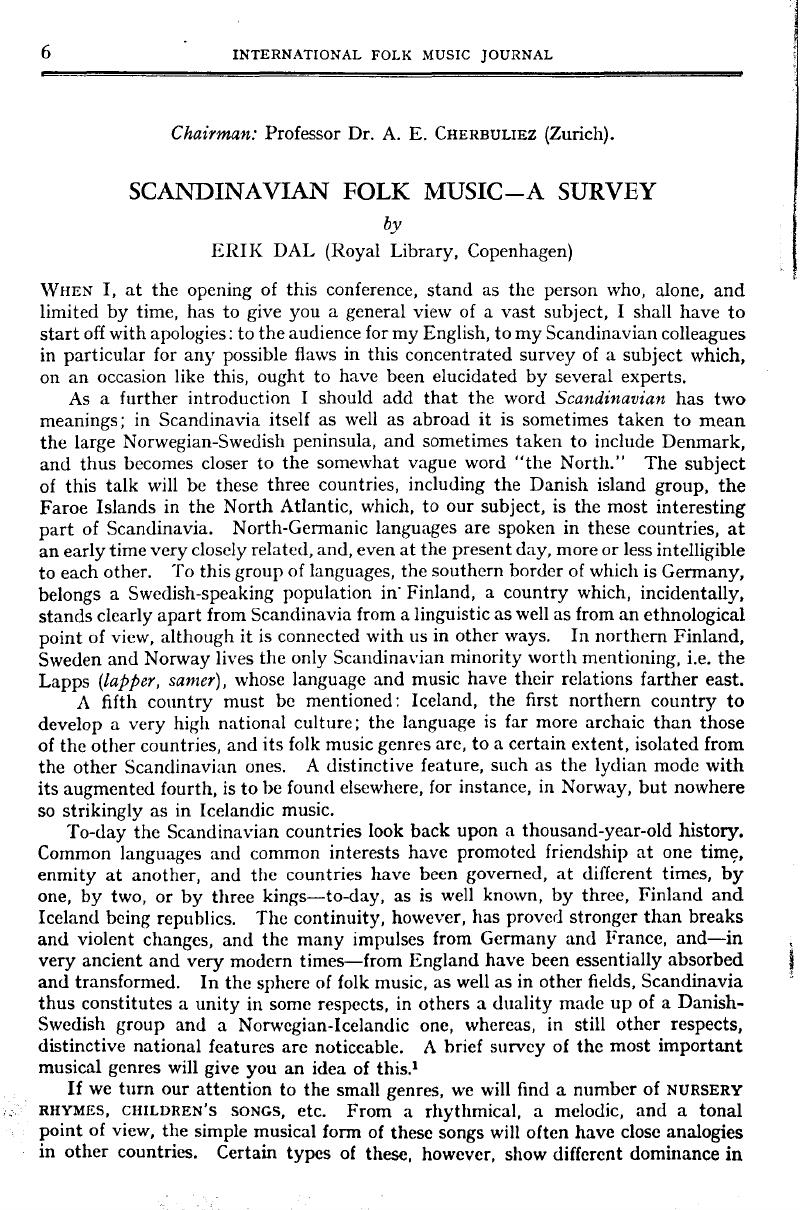No CrossRef data available.
Article contents
Scandinavian Folk Music—A Survey
Published online by Cambridge University Press: 07 March 2019
Abstract
An abstract is not available for this content so a preview has been provided. Please use the Get access link above for information on how to access this content.

- Type
- Proceedings of the Eighth Conference of the International Folk Music Council Held at Oslo, Norway
- Information
- Copyright
- Copyright © International Council for Traditional Music 1956
References
1.Comprehensive bibliographical information on the folk music of the Scandinavian, as well as other, countries is given in: Musique et chanson populaires, Société des Nations, Paris, 1934, and Folklore musical. Paris, 1939. See also Werner Danckert: Das europäische Volkslied, Berlin, 1939, a survey with a good bibliography, and Nordisk Kultur, Stockholm, Oslo, København (IX A, 1931: Folkevisor, XXIV B, 1933: Dans, XXV, 1934: Musik och musikinstrumcnt). The study of Scandinavian ballads is treated in a masterly way in Sigurd Bernhard Hustvedt: Ballad Criticism in Scandinavia and Great Britain during the Eighteenth Century, American-Scandinavian Foundation, New York, 191O, and Ballad Books and Ballad Men, Cambridge, USA, 1930; folkloristic studies in general, especially in Scandinavia and Germany, in Ingcr M. Boberg: Folkernindeforskningens historie i Melletn og Nordeuropa, Copenhagen, 1953 Danmarks Folkeminder No. 60), which has a long summary in English. Bibliographical notices about Faroese balladry are given in H. Gröner-Nielsen: De fæøroske Kvadmelodiers Tonalitet i Middelalderen, Copenhagen, 1945 (Fæoensia I, with English summary). An up-to-date Norwegian bibliography is Øystein Gaukstad:: Norsk folkemusikk. Ein bibliografi, Oslo, 1951 (in Norsk musikkgranskning, 1947-50, and separately). Of bibliographical importance is also Nils Schiørring's dissertation: Det. 16. og 17. urhundrcdes verdslige danske visesang, I-II, Copenhagen, 1950. The present writer hopes to publish in the autumn of 1956 his own studies on the Scandinavian ballad under the title, Norsk folkevise/orskning siden 1800 (with a 35-page summary in English).Google Scholar
2.Danmarksgamle Folkeviser, I-IX, 1853-1923, by Svend Grundtvig, Axel Olrik, H. Grüner- Nielsen. X, Appendix, 1933 sqq., unfinished. XI, Music, 1935, sqq., unfinished. A plan for the unfinished volumes and for vol. XII, indexes, etc., has been made, see Erik Dal in Danske Studier 1955 (Copenhagen, 1955).Google Scholar
3.Editions with music. In Norway: Landstad, 1953 (mostly ballads), and different publications by L. M. I.indeman. In Sweden: Afrelius and Geijer, 1814-16, new edition, 1880 (mostly ballads), Arwidsson, 1837-42 (also other songs), Aug. Fredin: Gotlandstoncr, 1909, sqq. In Swedish Finland: Finlands svenska folkdiktning V, Den äldra folkvisan, utg. av Otto Andersson, Helsingfors, 1934. The principal monograph of Faroese folk song is Hjalmar Thuren: Folkesangen paa Færøeme, Copenhagen, 1908 (FF Publications, Northern Series No. 2, with a summary in German); tunes to ballads imported from Denmark, see Hjalmar Thuren and H. Grüner- Nielsen: Færoske Melodier til danske Kaempeviser, Copenhagen, 1923. The Icelandic main edition is Bjarni porsteinsson: íslenzk piódlog. Copenhagen, 1906-9.Google Scholar
4.Names and titles, see Gaukstad's bibliography in Note 1. L. M. Lindeman, Catharinus Filing, and O. M. Sandvik may be called the most prominent Norwegian folk music scholars; together they cover more than a century; all of them, and also Erik Eggen and others, have discussed the question here mentioned.Google Scholar
5.A. P. Berggreen collected an eleven-volume collection of folk songs from all parts of the world; the three Scandinavian volumes are still important (Folkesange og Melodier, fxdrelandske og fremmede, 2nd edition, Copenhagen, 1860, sqq.; 3rd edition of the Danish vol., 1869).Google Scholar
6.In Denmark, the texts of some of these genres were edited by II. Grüner-Nielsen (Danske Viser, 1530-1630), I-VII, Copenhagen, 1912, sqq). Schinrring's book, see note I, deals with their music. For other countries, see the works mentioned above.Google Scholar
7.The late Swedish musicologist Tobias Norlind has made many contributions to the history of dances and instruments. Other organologists arc Otto Andersson, Finland; Arne Bjerndal, Norway; and the late Hortense Panum, Denmark.Google Scholar
8.Svenska latar, Stockholm, 1921, sqq.Google Scholar




